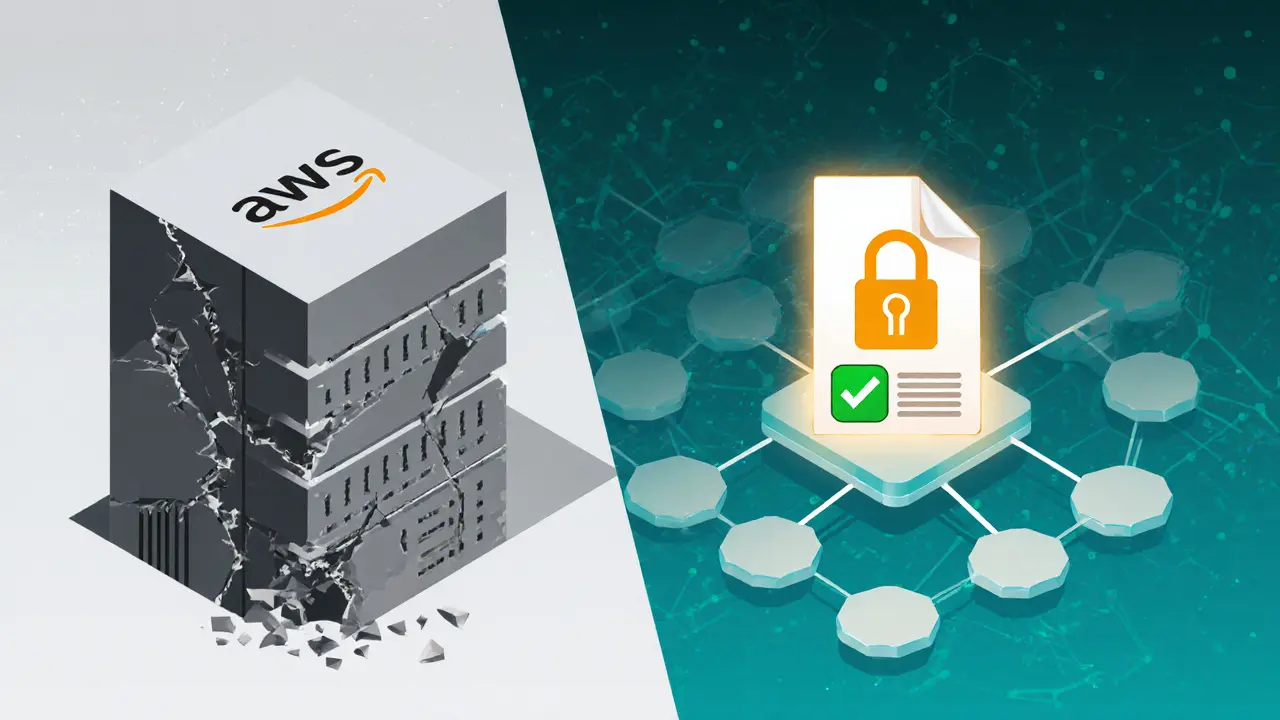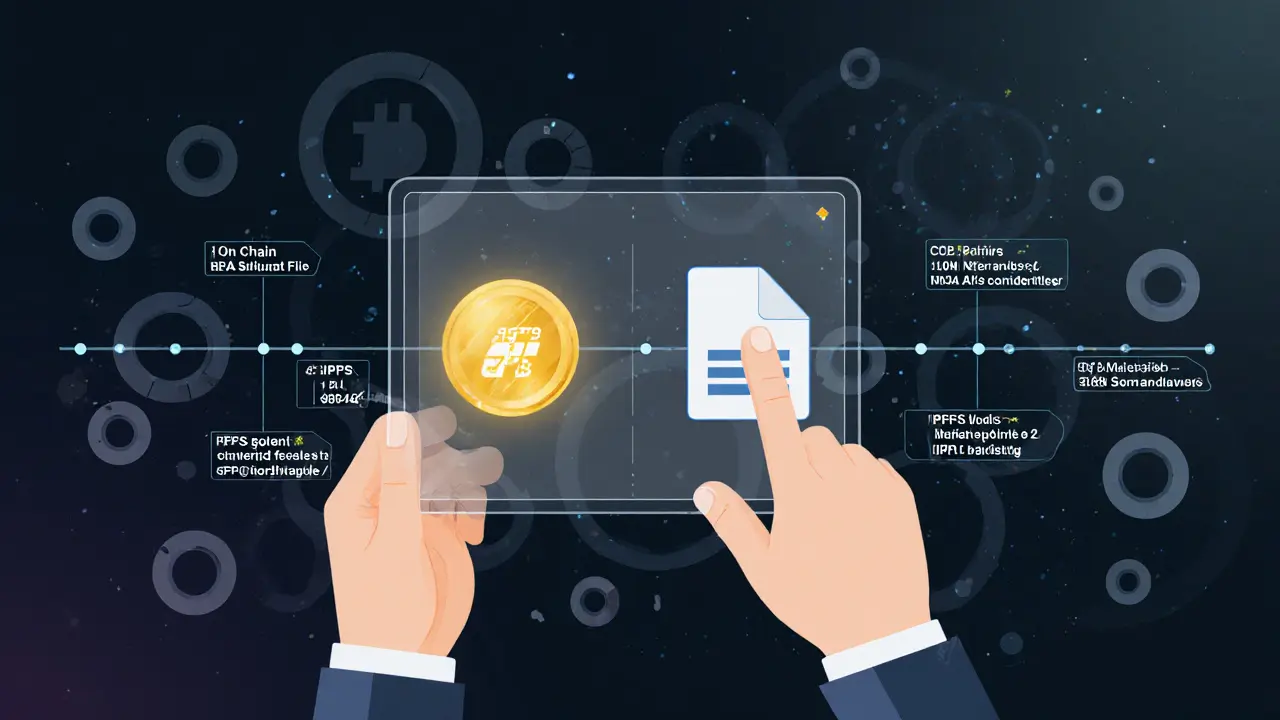NFT Metadata Storage Checker
Enter an NFT metadata URL or CID to check if it's stored in a reliable system with immutable provenance information. This tool helps you verify whether your NFT's metadata is securely stored and protected from changes.
When you buy an NFT, you’re not just buying a picture. You’re buying a digital certificate that says you own this specific version of something - whether it’s art, music, or a virtual sneaker. But here’s the problem: if the image disappears, or the website hosting it goes down, does your ownership still mean anything? That’s where NFT metadata comes in. It’s the hidden layer that keeps the story of who owned what, when, and how - alive, even when the platform vanishes.
What Exactly Is NFT Metadata?
NFT metadata is just data - plain text in JSON format - that describes what the NFT actually is. Think of it like a digital birth certificate. It includes the name, description, and image file link. But the most important part? It records the history. Who created it? When was it first minted? Who owned it before you?
This info isn’t stored directly on the blockchain. That’s too expensive. Ethereum charges about $1,200 per MB to store data on-chain. Instead, the blockchain holds a link - a pointer - to where the metadata lives. That link is called a tokenURI. It’s like a URL, but it’s designed to be tamper-proof. If someone changes the metadata file, the link breaks, and the blockchain knows something’s off.
How Provenance Gets Written Into the Metadata
Provenance means the full ownership history. A good NFT metadata file doesn’t just say, “This was made by X.” It says, “This was made by X on March 12, 2023. It was sold to Y on April 5, 2023. Then to Z on June 18, 2024.”
Most NFTs use the ERC-721 standard, which doesn’t force creators to include provenance fields. So many skip it. But the ones that matter - the ones you want to hold onto - include a history field. Some newer standards, like Hedera’s HIP-412, make it mandatory. They require creators to list the original artist, creation date, and a log of every transfer. That’s how you know it’s not a copy.
And here’s the key: the blockchain records every transfer. The metadata just tells you what was transferred. Together, they form a complete story. Without metadata, you have a transaction record with no context. With metadata, you have a verified, unchangeable timeline.
Where Is the Metadata Stored? (And Why It Matters)
There are three main places NFT metadata lives:
- Centralized servers - like Amazon Web Services or Cloudflare. Used by 63% of NFT projects because it’s easy. But if the company shuts down or gets sued, the art vanishes. In April 2025, Nike’s CloneX collection lost access to its images because Cloudflare blocked their server. The NFTs still existed on the blockchain - but the pictures? Gone. Provenance? Broken.
- IPFS (InterPlanetary File System) - a decentralized network. Used by 32% of collections. Files are stored across thousands of computers. Each file gets a unique hash (CID) based on its content. If someone changes the image, the hash changes. The blockchain link breaks. That’s how you know it’s been tampered with. But here’s the catch: if no one “pins” the file (keeps a copy alive), it can disappear in six months. 47% of unpinned IPFS files vanish within that time.
- Arweave - pays once, stores forever. Used by 5% of projects. You pay a one-time fee (around $0.03 per MB) and the file is stored permanently. No pinning needed. But it’s not widely supported yet, so not all wallets or marketplaces can read it.
- On-chain - stored directly on the blockchain. Only 0.3% of NFTs use this. CryptoPunks are the most famous example. It’s bulletproof - no link to break, no server to fail. But you can only fit about 4,000 characters. That’s enough for a simple SVG image, not a 10MB JPEG.
The best practice? Store the actual file on IPFS or Arweave, and put the hash of that file on-chain. That way, you can prove the file hasn’t changed. The 0N1 Force collection does this perfectly. Their metadata includes the exact hash of the image. Anyone can check it against the blockchain. If they match? The asset is real.

The Big Risk: Mutable Metadata
Here’s the scary part: 41% of NFT collections allow the creator to change the metadata after minting. That means the artist can swap out the image, delete the history, or even rename the NFT. Suddenly, your Bored Ape looks like a monkey holding a banana. And the blockchain has no way to stop it.
This isn’t theoretical. On Reddit, users posted about their NFTs losing their original art because the metadata was updated. One user’s $50,000 NFT became a low-res blurry image. The blockchain still showed him as the owner - but the asset he bought? Gone.
That’s why trusted collections lock their metadata. Once minted, it can’t be changed. That’s what makes it truly verifiable. If you’re buying an NFT, check if the metadata is immutable. If it’s not, you’re not buying ownership - you’re buying a promise that might disappear tomorrow.
What’s Changing in 2025?
The industry is waking up. In June 2024, the Ethereum Name Service (ENS) launched its Provenance Protocol. It embeds cryptographic proof of metadata integrity directly into NFTs. Now, you can verify not just that you own the token, but that the file it points to hasn’t been altered since minting.
NFT.Storage, which handled 2.7 million uploads in Q2 2024, now integrates with the Filecoin Virtual Machine. This lets smart contracts check if the file is still stored properly - no manual checks needed. That’s a huge step toward automation and trust.
Experts agree: the future is decentralized storage with on-chain verification. Vitalik Buterin said in early 2024, “NFTs without persistent metadata are just pointers to potentially ephemeral content.” Dieter Shirley from Dapper Labs warned that 60-70% of NFTs from 2021-2022 are already at risk because they rely on centralized servers.
By 2027, 95% of high-value NFTs are expected to use decentralized storage, according to Protocol Labs. But right now, 40-60% of NFTs created before 2023 could lose their provenance in five years if nothing changes.

What Should You Do?
If you’re collecting NFTs:
- Check the metadata source. Is it on IPFS or Arweave? Look up the CID in a browser like ipfs.io (you can paste the CID there). If it loads, it’s live.
- Verify the metadata is immutable. Look for a lock icon or a note from the project saying “metadata locked.” If it says “creator can update,” walk away.
- Don’t trust marketplaces alone. OpenSea or Blur might show your NFT fine today. But if they go down, your access vanishes. Only the blockchain and the metadata file matter.
- For high-value NFTs, download the metadata and image yourself. Save the JSON file and the image in two places. You never know when a platform will disappear.
If you’re creating NFTs:
- Use IPFS or Arweave. Don’t use centralized servers.
- Lock your metadata. Once it’s live, don’t give yourself the power to change it.
- Include provenance fields: creator, creationDate, and history. Even if it’s not required, it builds trust.
- Put the file hash on-chain. That’s your proof of authenticity.
Frequently Asked Questions
Can NFT metadata be changed after minting?
Yes, if the creator built that ability into the smart contract. About 41% of NFTs allow this. But it breaks provenance. Trusted collections lock metadata permanently. Always check before buying.
What happens if the image linked in NFT metadata disappears?
The NFT still exists on the blockchain - you still own the token. But the artwork, audio, or video it represents is gone. Buyers can’t see it. Resale value drops to zero. That’s why decentralized storage like IPFS and Arweave is critical.
Is on-chain metadata better than off-chain?
On-chain is 100% permanent but extremely expensive and limited in size. Only simple SVGs fit. Off-chain (IPFS/Arweave) is cheaper, supports high-res files, and can still be verifiable if hashes are stored on-chain. Most experts recommend off-chain storage with on-chain verification.
How do I verify an NFT’s provenance myself?
Find the metadata link (usually in the NFT’s contract details). Download the JSON file. Look for the image URL - it should be an IPFS CID or Arweave hash. Paste that CID into ipfs.io or arweave.net. If the image loads, it’s still live. Compare the file hash in the metadata to the one on-chain - they should match exactly.
Why do some NFTs have no provenance info at all?
Because the ERC-721 standard doesn’t require it. Many creators prioritize speed and cost over long-term value. They assume the platform will always be there. But platforms fail. Without provenance, NFTs are just digital collectibles with no verifiable history - and that makes them risky investments.


10 Responses
Most NFTs are garbage. If your art disappears when the server goes down, you never owned anything. Just a digital receipt for a ghost.
Really glad someone laid this out clearly. I’ve been buying NFTs for a year and only just learned to check IPFS hashes. Saving this for my next purchase.
Arweave is the real MVP here. Pay once, store forever? That’s the kind of innovation that actually solves problems instead of just making flashy NFTs with JPEGs that vanish. Kudos to the projects using it.
Let me break this down for the folks still thinking OpenSea = ownership. The blockchain doesn’t store your art. It stores a link. And links break. IPFS isn’t magic-it needs pinning. Arweave is the only one that actually guarantees persistence. If you’re holding something valuable, download the metadata and the image. Right now. Not tomorrow.
Y’all are overcomplicating this. If your NFT art can be changed by the artist, it’s not art-it’s a sponsored ad with a blockchain sticker. The whole thing is a scam. Why do you think they call it ‘crypto’? Because you’re getting played.
Think about it this way: ownership isn’t about the file-it’s about the story. The blockchain records the chain of custody. The metadata tells you what was transferred. Together, they’re the digital equivalent of a family heirloom with a handwritten letter explaining its origin. Without that letter? It’s just a shiny rock. With it? It’s legacy.
People don’t realize how much of this is just theater. ERC-721 doesn’t require provenance? That’s like selling a car without a title. The industry’s still in its Wild West phase. But the shift is happening-projects locking metadata, using decentralized storage, embedding hashes on-chain. The winners will be the ones who treat NFTs like assets, not collectibles.
So I just checked my Bored Ape’s metadata link… it’s on IPFS but the CID doesn’t load on ipfs.io. 😬 I thought I was safe. Now I’m paranoid. Should I just download everything and store it on an old hard drive in a safe? Is that even enough? Anyone else feel like they’re holding digital smoke?
Adrian, you’re not alone. I downloaded all my NFT metadata last week after reading this post. I’ve got a folder labeled ‘Digital Heirlooms’ on three drives now. One’s in the cloud, one’s at my mom’s house, one’s in a fireproof box. It’s overkill? Maybe. But if my kid inherits this someday, I want them to know what they’re holding isn’t just pixels.
Y’all are stressing too hard. I’ve got 12 NFTs. Two of ‘em lost their art last year. Big deal. I still got the transaction history. I’m not buying art-I’m buying community. The image? Just the wrapper. The real value’s in the Discord server and the memes.